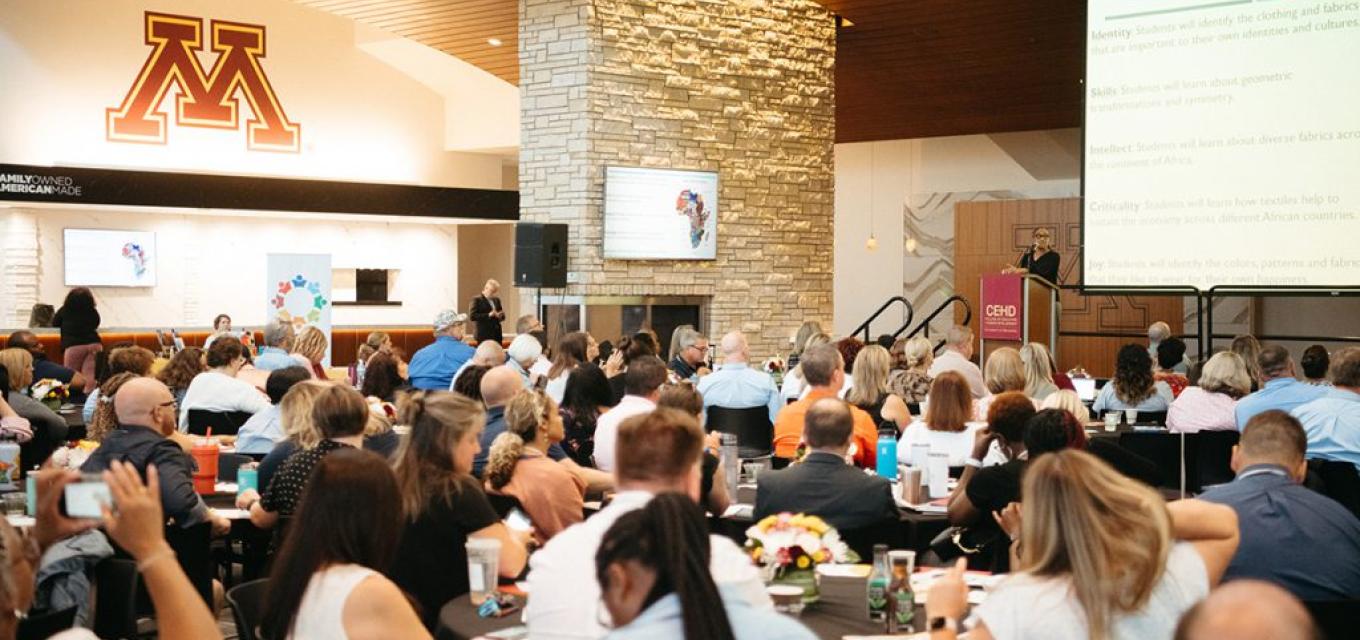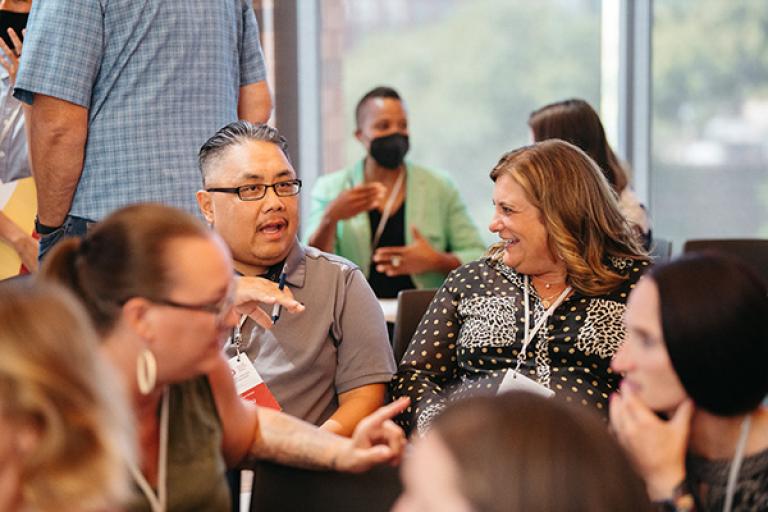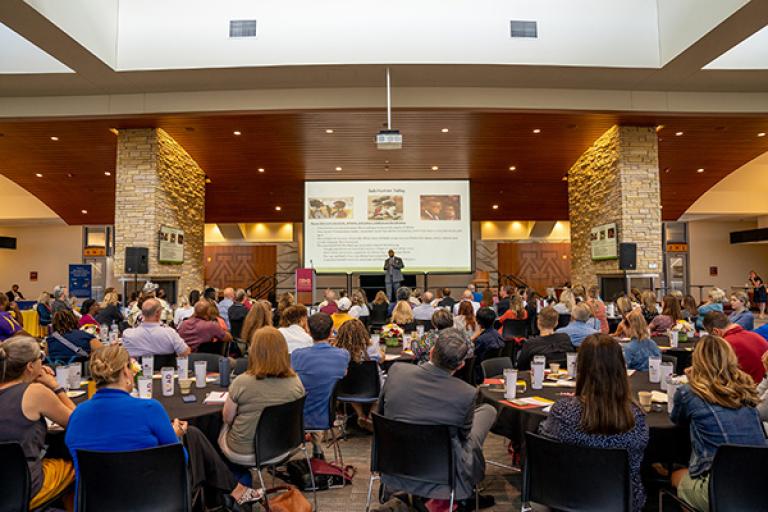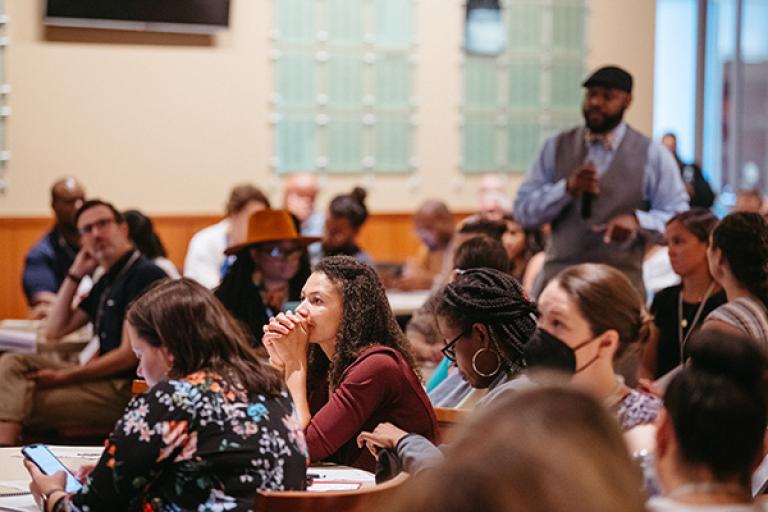2022 Fall

Building community, raising voices
LEAD Conference offers insights into creating more equitable education systems.
This August marked the return of the Leading in Equity, Action, and Diversity (LEAD) conference, a CEHD-sponsored event designed to give education leaders the tools and ideas necessary to disrupt pervasive racial inequities in PreK-12 schools. Absent for several years, this conference is the relaunch of at least a five-year run of the event.
Nearly 350 educational leaders from around the state gathered for the two-day conference, held August 2 and 3 at Huntington Bank Stadium. Each walked away with new skills and strategies to implement in their respective schools.
Keynote speakers Muhammad Khalifa and Gholnescar (Gholdy) Muhammad set the tone for the two days with their lively and informative presentations. Muhammad, a nationally recognized educator, researcher, and author, demonstrated her HILL Model, an equity framework of teaching that helps educators develop students’ Histories, Identities, Literacies, and Liberation. “How will your instruction help students to create social change for their communities?” she challenged the audience.
Khalifa, a professor of educational administration and the executive director of Urban and Rural Initiatives at The Ohio State University, said that among the responsibilities educators have, antiracist leadership needs a place at the table. He focused on how leaders can engage, and he pointed to two areas that became a common refrain heard throughout the conference. “There is knowledge within our students and the community that we need to recognize as knowledge,” he said.
Community engagement
Community engagement was a primary theme in Darrius Stanley’s breakout session, “Listening, Engaging, Advocating, and Partnership (LEAP): A Model for Responsible Community Engagement for Educational Leaders.” Stanley, a new assistant professor of educational leadership in the Department of Organizational Leadership, Policy, and Development, asked his audience what the word community meant to them.
“Most of us think of the neighborhood, but what is community in the context of education?” he asked.
Stanley grew up in Tallahassee, Florida, and used an example from his hometown to drive his message. Barrow Hill School is a community supported school, meaning that all the leaders in the vicinity came together to create it and make it run—the carpenters who built it, the farmers who provided food, the teachers who instructed—all lived in the area.
The success of the school involves an active approach to community engagement. “ ‘How do we do it?’ is the number one question I get,” Stanley said.
The first thing to do is listen, which is trickier than it sounds. Stanley referenced a common saying from his own mother: “Did you hear me or were you listening?” Hearing is passive; listening is active. After listening comes engaging. That means being present, building relationships, and anticipating the needs of the community. Advocating for these needs follows, and here Stanley pointed out a possible pitfall. Say you fought to get laptops to all your students and you succeeded. Then you hear from a parent: “Thanks for the laptop, but we don’t have WiFi at my house.” You forgot the first step. You didn’t listen.
Partnering is the last step. Here, Stanley returned to the Barrow Hill School. “The school was not just for education. It was for any community meeting outside of church. It’s a hub of knowledge,” he said, telling the audience they can do the same. “Leverage the school space as a community asset.”
Listening to the "customer"
Community was also a key concept for Michael Walker in his breakout, “Community Engaged Leadership in Action: Transforming Belief Systems through the Office of Black Student Achievement.” Walker is the founder and CEO of Critical Questioning consulting, which works with districts across the country to provide a framework that supports Black students.
In 2014, he was working as an assistant principal of Roosevelt High School in Minneapolis when he was handpicked to be the inaugural director for the Office of Black Male Student Achievement, with the responsibility of changing academic outcomes for Black males who attend Minneapolis Public Schools.
A couple weeks into his new assignment, he was asked what he was going to do. Walker told his supervisors he was going to do 100 days of listening. “We’re going to barbershops and hair salons,” he had said. “There is raw, uncut, real truth in those spaces.”
Walker came away with stories of broken beliefs based on individuals’ and their children’s experiences with schools. “Parents and families didn’t believe schools had equality,” he said. “Young Black men didn’t feel connected to their schools.”
To counter this narrative and try to reverse it, Walker created a belief framework through a new class, BLACK (Building Lives Acquiring Cultural Knowledge). Dontrell Bradley had been in the class since eighth grade. “The whole classroom was a different feeling,” he said. “It taught me leadership skills, not to be shy, say your feelings, and your feelings matter.”
Walker closed by showing how Malcolm X exemplified what he was talking about. “He intentionally changed three or four times in his life based on new information he found,” Walker said. “That’s the definition of a lifelong learner. Do we as educators do that when we find new information or do we just let it sit there?”
Raising student voices
St. Louis Park Public Schools takes listening to students quite seriously and this was demonstrated at “Student Voice at the Table: Youth Internships to Analyze School Policy and Practices.” District Superintendent Astein Osei said their mission was about empowering students. “We want to create an environment with students at the center,” he said.
Silvy Lafayette, the director of assessment, research, and evaluation, introduced the district’s approach. “We hire students to study data—youth data analyst summer interns,” she said. “This idea comes from University of Minnesota work. We hired undergrads at the U to do research, why couldn’t we replicate a similar model at our high school?”
 |
 |
 |
| Photos by Jayme Halbritter |
Several of the student interns, Walter Gips, Abdulkadir Mohamud, LaMark Pierce, Whitney Shill, and Annalee Wold, were present to talk about their project, which was to determine how the St. Louis Park discipline system affected students.
The students conducted 10-minute interviews with 68 of their peers, collected the responses, and analyzed the data. In general, students saw favoritism, noticed that students of color seemed to be disciplined more often, and believed that learning and grades declined when you were taken out of class. The recommendation was to require staff to build better relationships with students that promote trust and belonging.
A takeaway for the students, when asked, was they appreciated their voice was acknowledged. “Normally, adults don’t really listen to you,” Gips said.
For attendees of the conference, the takeaways were many. “It was exhilarating to participate in a conference centered on equity and diversity,” says Matt Pletcher, the director of secondary curriculum and instruction and multilingual programs at Robbinsdale Area Schools. “Each of the presenters was outstanding and delivered content that was easily applicable to my school district. I walked away inspired and ready to transform our systems to better meet the needs of our diverse community of learners.”
-KEVIN MOE